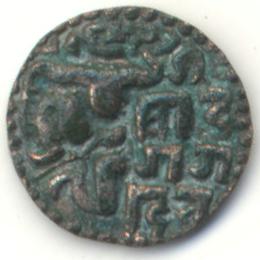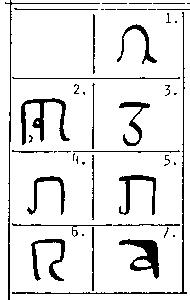| SPECIFICATIONS | |
| Denomination | massa |
| Alloy | Copper |
| Type | Struck |
| Diameter | 21.07 mm |
| Thickness | mm |
| Weight | 4.05 gms |
| Shape | Round |
| Edge | Plain |
| DieAxis | O° |


|

| 
| ||||||||||||||||||||
| Codrington #79 | Mitchiner not-represented | |||||||||||||||||||||
|
Obverse : Traditional Lankan massa design of standing king. The head consists of an irregular oblong, the right side being a vertical line, from which projects three horizontal stokes representing the nose, mouth and chin. The crown bulging outwards at the back. The two curved lines on either side of the legs slightly turned upwards at the end indicate a person wearing a 'dhoti', and standing on a lotus stalk with flower to the right. The forearm is bent sharply down; the hand grasps the hanging lamp. The right side elbow is curved down with the arm turned upwards holds a flower presumed to be a jasmine blossom. To the right are five dots or spheres. A rim of 40 to 43 beads. Reverse : Traditional Lankan massa design of seated king. Head and crown as on obverse. Arm is raised upwards and the hand holds a conch shell. On right Nagari legend Sri Co da ga (m)ga de va. | 
|
This is a very rare coin unlike the six common copper massa coins from the late Polonnaruwa and Dambadeniya era. The base silver type is also known.
On the death of NissankaMalla
to quote history from the direct translation of the ancient chronicle Culavamsa
His son, the King known by the name of Virabahu, here upon ruled for
one night and then fell into the power of death.
There upon the younger brother of that same king Kittinissanka, King Vikkamahahu, enjoyed the royal dignity for three months. He was slain by the Ruler Colaganga, a sister's son of King Nissanka, who carried on the government for nine months. Thereupon the powerful general Kitti had the eyes of this king put out, deposed him and had the government carried on for three years without mishap by Lilavati, the first mahesi of the sovereign Parakkamabahu.
Text edited from
* Ceylon Coins and Currency: H. W. Codrington, Colombo, 1924.
Chapter VI Mediaeval Lanka - Sinhala of 12th & 13th Century - Series I, Page 68
* Culavamsa II Chapter LXXX: Translation by Wilhelm Geiger. Pali Text Society 1930
The coin was scanned at 300dpi and displayed at 300dpi. It was obtained in December 1999 from Rajah Wickremesinhe an Author and collector in Colombo, Lanka.